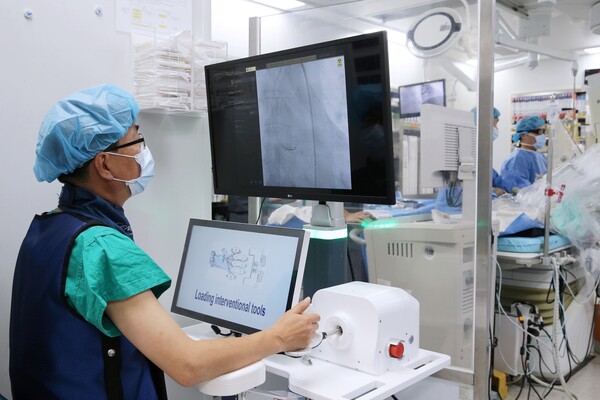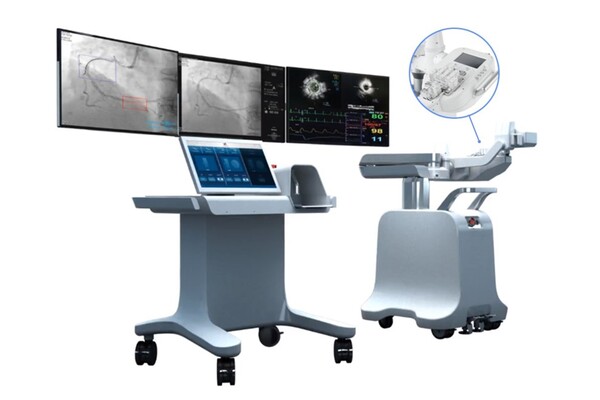
A robot developed by Asan Medical Center (AMC)'s Institute of Biomedical Engineering is attracting attention after the hospital's cardiologists performed a successful heart stent procedure on a patient with angina using it.
This marks a significant development in the domestic robotic surgical device market, which has relied on foreign suppliers, including the U.S., Germany, and France, as it is the first procedure using the coronary intervention robot developed by Korean medical professionals, industry watchers said.
AMC said Wednesday that Professors Lee Seung-hwan and Kim Tae-oh of the hospital's Cardiology Department safely treated a male patient, 50, who was suffering from angina pectoris, with percutaneous coronary intervention using the robot.
The patient, treated more precisely and safely by the robot, was discharged from the hospital a day after the procedure without complications, the hospital added.
AVIAR, the coronary intervention assistant robot developed by Professor Choi Jae-soon of the Institute of Biomedical Engineering and Professor Kim Young-hak of the Department of Cardiology, won approval from the Ministry of Food and Drug Safety in February. It is used in procedures for empirical clinical research at AMC and the Catholic University of Korean Eunpyeong St. Mary's Hospital.
AMC is also working towards exporting its first robot to the U.S. and Europe.
Percutaneous coronary intervention (PCI) is a procedure in which a thin catheter is inserted through the femoral artery in the patient's groin or a blood vessel in the wrist to the heart's coronary artery. Then, a balloon is inserted into the narrowed coronary artery to widen the blood vessel and deploy a stent. It is performed for patients with angina pectoris, myocardial infarction, and coronary artery narrowing or blockage due to arteriosclerosis or blood clots.
The procedure involves inserting a hair-thin device into a microscopic blood vessel, requiring skilled medical professionals because the lesions in the coronary arteries vary from patient to patient and are complex. In addition, because it involves treating blood vessels in the body that cannot be seen with the naked eye, the procedure uses X-ray fluoroscopy to ensure that the stent reaches the correct location. For those treating multiple patients, the risk of constant radiation exposure from repeated X-rays is high.

The coronary artery bypassing graft (CABG)-assisting robot comprises a computer and a handle that mimics a doctor's hand. A joystick-like handle maneuvers the CABG robot to guide the wire to the target lesion in the patient's coronary artery and then introduces a balloon and stent to dilate the vessel. The steering wheel can be moved with an error of 1 millimeter per movement.
The handle is also equipped with haptics, which allows the user to feel the subtle sensations of the procedure with their hands. The computer part of the coronary intervention robot displays various data required for the procedure based on artificial intelligence to help medical workers accurately judge the procedure situation.
It analyzes the patient's blood vessel curve during the procedure and shows any abnormalities. Previously, the procedure relied on the know-how of skilled medical workers. However, with the CABG robot, it is possible to make fine adjustments using the robot, making the procedure more accurate and precise.
Moreover, the robot is expected to minimize radiation exposure for both medical professionals and patients by reducing procedure time and enabling medical staff to perform procedures away from the X-ray machine.
"Through the robot’s fine control, we could accurately insert the stent into the patient's lesion without error, and the patient was discharged from the hospital without any complications," Professor Lee said. "It is expected that high-risk patients with complex or difficult coronary lesions will be treated more safely using the coronary intervention assistant robot, as it allows for more precise procedures."
Meanwhile, AVIAR, a CABG-assisting robot developed thanks to AMC’s medical robot technology and know-how, is being commercialized through LN Robotics.
As an early version prototype, the robot completed clinical trials up to the exploratory stage in October 2019. Over the next three years, the robot refined and expanded its functions and obtained approval from MFDS. In October, the robot successfully performed surgery at AMC for the first time in Korea.
"With the coronary intervention assistant robot, remote interventional procedures for emergency patients or non-face-to-face interventions for patients concerned about infection become feasible in the future, and it is expected to improve the level of medical care in medically underdeveloped areas through telemedicine," Professor Choi said. "We plan to develop the robot further to be applied to coronary arteries and various cerebrovascular and peripheral vascular procedures."

